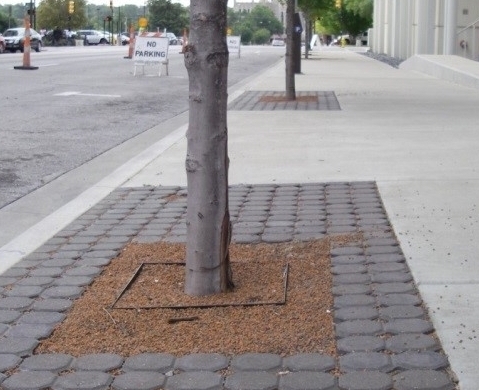Pervious surfaces allow stormwater, that would normally run off into a stormwater drain, to seep into the ground. Pervious concrete is instrumental in recharging groundwater, reducing stormwater runoff, and meeting U.S. environmental Protection Agency (EPA) stormwater regulations. In fact, the use of pervious concrete is among the Best Management Practices (BMPs) recommended by the EPA– and by other agencies and geotechnical engineers across the country– for the management of stormwater runoff on a regional and local basis. This pavement technology creates more efficient land use by eliminating the need for retention ponds, swales, and other stormwater management devices. In doing so, pervious concrete has the ability to lower overall project costs on a first-cost basis. (from perviouspavement.org)
Pervious Pavement

Fact Sheets and Other Resources
- Pervious Concrete Pavement for Stormwater Management, University of New Hampshire
- Pervious Concrete Paving, United Facilities Guide Specifications
- Pervious Paving,Sustainable Cities Institute
- Assessment of Pervious Concrete Maintenance Techniques, Concrete In Focus magazine
- Maintaining Permeable Pavements, North Carolina State University
- Permeable Pavement: Research Update and Design Implications, North Carolina State University
- Pervious Concrete, TERRA Road Alliance
- Pervious Concrete and Freeze-Thaw, cement.org
- Pervious Concrete as a Flooring Material for Horse Handling Areas, University of Kentucky Cooperative Extension Service
- Dry Wells, California State Water Resources Control Board
- Porous Pavement, EPA
Bulletins, journal articles, and Handbooks
- Pervious Concrete Pavements: A good complete document regarding design, construction, and maintenance of pervious concrete from the Portland Concrete Association and the National Ready-mixed Concrete Association.
- Pervious Concrete Pavement Maintenance and Operations Guide, from the National Ready-mixed Concrete Association
- Estimating Pervious PCC Pavement Design Inputs with Compressive Strength and Effective Void Content, Crouch et al., Tennessee Concrete Association
- Effective Curve Number and Hydrologic Design of Pervious Concrete Storm-water Systems, Schwartz, 2010. Journal of Hydrologic Engineering.
- Pervious Pavements SD-20, California Stormwater BMP Handbook
- Permeable Interlocking Concrete Pavement – A Comparison Guide to Porous Asphalt and Pervious Concrete, Interlocking Concrete Pavement Institute (please note that this is a trade publication and presents the information in a somewhat biased fashion, but it still has a lot of good information in it)
Videos
- Introduction to Pervious Pavement, Oklahoma Gardening
- Pervious Paving Demonstration, Oklahoma Gardening
- Making Pervious Concrete, Oklahoma Gardening
- Permeable Pavement, UNL Stormwater Management Education Team
- Pervious Concrete Information, Michigan Concrete Association
- Installing a Permeable Pavement Driveway, Minnehaha Creek Watershed District, MN
Other Pervious Pavement Websites
- Pervious Concrete: When it rains, it drains…, National Ready-Mixed Concrete Association (this is a very good resource)

